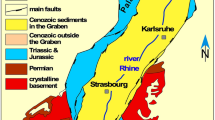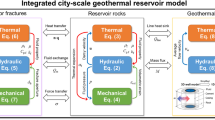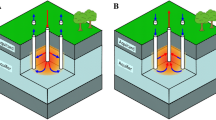Abstract
The thermal-hydrologic-mechanical (THM) coupled processes in water-based enhanced geothermal system (EGS) greatly influence the heat extraction performance of EGS. Many THM models have been proposed, however, there is a lack of detailed analysis of water storage, which is caused by the increments of reservoir porosity and water density, and the influence of water storage on the heat extraction performance needs to be uncovered. In this paper, a 3D THM model is established to simulate the water storage amount and heat extraction rate for a water-based EGS. The 3D THM model is verified against an analytical solution. Then, the influences of water storage are investigated, and comparisons between the THM and thermal-hydrologic (TH) processes are made for different initial reservoir porosities. The results show that the increment of reservoir porosity has a larger influence on water storage than that of water density. If ignoring water storage, the injection flow rate would be underestimated, while the production flow rate and heat extraction rate would be overestimated, and the reservoir would be cooled a little slower. Compared with the TH processes, the THM processes show larger cumulative water storage amount, higher steady-state heat extraction rate and higher cooling rate of reservoir, indicating that mechanical process has important influences on EGS performances. For higher initial reservoir porosity, the cumulative water storage amount is larger. It can be inferred that the water storage amount is related to the cooling rate of reservoir. The results of this paper show that water storage has a certain influence on the heat extraction rate, and that the mechanical process and initial reservoir porosity have important effects on the water storage amount, which should be simulated based on a THM model.
Similar content being viewed by others
References
Zhu J.L., Hu K.Y., Lu X.L., et al., A review of geothermal energy resources, development, and applications in China: Current status and prospects. Energy, 2015, 93: 466–483.
Wu J., Tang G., Wang R., et al., Multi-objective optimization for China’s power carbon emission reduction by 2035. Journal of Thermal Science, 2019, 28(2): 184–194.
Nikolai P., Rabiyat B., Aslan A., et al., Supercritical CO2: properties and technological applications—A review. Journal of Thermal Science, 2019, 28(3): 394–430.
Olasolo P., Juárez M.C., Morales M.P., et al., Enhanced geothermal systems (EGS): A review. Renewable and Sustainable Energy Reviews, 2016, 56: 133–144.
Pandey S.N., Vishal V., Chaudhuri A., Geothermal reservoir modeling in a coupled thermo-hydromechanical-chemical approach: A review. Earth-Science Reviews, 2018, 185: 1157–1169.
Cheng W.L., Wang C.L., Nian Y.L., et al., Analysis of influencing factors of heat extraction from enhanced geothermal systems considering water losses. Energy, 2016, 115: 274–288.
Zeng Y.C., Wu N.Y., Su Z., et al., Numerical simulation of heat production potential from hot dry rock by water circulating through a novel single vertical fracture at Desert Peak geothermal field. Energy, 2013, 63: 268–282.
Xu T., Feng G., Hou Z., et al., Wellbore-reservoir coupled simulation to study thermal and fluid processes in a CO2-based geothermal system: identifying favorable and unfavorable conditions in comparison with water. Environmental Earth Sciences, 2015, 73: 6797–6813.
Benim A.C., Cicek A., Eker A.M., A computational investigation of the thermohydraulics of an EGS project. Journal of Thermal Science, 2018, 27(5): 405–412.
Jeanne P., Rutqvist J., Vasco D., et al., A 3D hydrogeological and geomechanical model of an enhanced geothermal system at the Geysers, California. Geothermics, 2014, 51: 240–252.
Taron J., Elsworth D., Thermal-hydrologic-mechanical-chemical processes in the evolution of engineered geothermal reservoirs. International Journal of Rock Mechanics & Mining Sciences, 2009, 46: 855–864.
Lei H., Xu T., Jin G., TOUGH2Biot — A simulator for coupled thermal-hydrodynamic-mechanical processes in subsurface flow systems: Application to CO2 geological storage and geothermal development. Computers & Geosciences, 2015, 77: 8–19.
Huang X., Zhu J., Li J., et al., Parametric study of an enhanced geothermal system based on thermo-hydromechanical modeling of a prospective site in Songliao Basin. Applied Thermal Engineering, 2016, 105: 1–7.
Hu L., Winterfeld P.H., Fakcharoenphol P., et al., A novel fully-coupled flow and geomechanics model in enhanced geothermal reservoirs. Journal of Petroleum Science and Engineering, 2013, 107: 1–11.
Guo B., Fu P., Hao Y., et al., Thermal drawdown-induced flow channeling in a single fracture in EGS. Geothermics, 2016, 61: 46–62.
Fu P., Hao Y., Walsh S.D.C., et al., Thermal drawdown-induced flow channeling in fractured geothermal reservoirs. Rock Mechanics and Rock Engineering, 2016, 49: 1001–1024.
Jacquey A.B., Cacace M., Blöcher G., et al., Thermo-poroelastic numerical modelling for enhanced geothermal system performance: Case study of the Groß Schönebeck reservoir. Tectonophysics, 2016, 684: 119–130.
Kelkar S., Lewis K., Karra S., et al., A simulator for modeling coupled thermo-hydro-mechanical processes in subsurface geological media. International Journal of Rock Mechanics & Mining Sciences, 2014, 70: 569–580.
Cao W.J., Huang W.B., Jiang F.M., A novel thermal-hydraulic-mechanical model for the enhanced geothermal system heat extraction. International Journal of Heat and Mass Transfer, 2016, 100: 661–671.
Sun Z.X., Zhang X., Xu Y., et al., Numerical simulation of the heat extraction in EGS with thermal-hydraulic-mechanical coupling method based on discrete fractures model. Energy, 2017, 120: 20–33.
Wang S., Huang Z., Wu Y.S., et al., A semi-analytical correlation of thermal-hydraulic-mechanical behavior of fractures and its application to modeling reservoir scale cold water injection problems in enhanced geothermal reservoirs. Geothermics, 2016, 64: 81–95.
Zhao Y., Feng Z., Feng Z., et al., THM (Thermo-hydromechanical) coupled mathematical model of fractured media and numerical simulation of a 3D enhanced geothermal system at 573 K and buried depth 6000–7000 m. Energy, 2015, 82: 193–205.
Li S., Feng X.T., Zhang D., et al., Coupled thermo-hydro-mechanical analysis of stimulation and production for fractured geothermal reservoirs. Applied Energy, 2019, 247: 40–59.
Watanabe N., Wang W., McDermott C.I., et al., Uncertainty analysis of thermo-hydro-mechanical coupled processes in heterogeneous porous media. Computational Mechanics, 2010, 45: 263–280.
Hicks T.W., Pines R.J., Willis-Richards J., et al., A hydro-thermo-mechanical numerical model for HDR geothermal reservoir evaluation. International Journal of Rock Mechanics & Mining Sciences, 1996, 33(5): 499–511.
Jing Y., Jing Z., Willis-Richards J., et al., A simple 3-D thermoelastic model for assessment of the long-term performance of the Hijiori deep geothermal reservoir. Journal of Volcanology and Geothermal Research, 2014, 269: 14–22.
Ghassemi A., Nygren A., Cheng A., Effects of heat extraction on fracture aperture: A poro-thermoelastic analysis. Geothermics, 2008, 37: 525–539.
Ghassemi A., Zhou X., A three-dimensional thermo-poroelastic model for fracture response to injection/extraction in enhanced geothermal systems. Geothermics, 2011, 40: 39–49.
Pandey S.N., Chaudhuri A., Kelkar S., A coupled thermo-hydro-mechanical modeling of fracture aperture alteration and reservoir deformation during heat extraction from a geothermal reservoir. Geothermics, 2017, 65: 17–31.
Pandey S.N., Vishal V., Sensitivity analysis of coupled processes and parameters on the performance of enhanced geothermal systems. Scientific Reports, 2017, 7: 17057.
Salimzadeh S., Paluszny A., Zimmerman R.W., Three-dimensional poroelastic effects during hydraulic fracturing in permeable rocks. International Journal of Solids and Structures, 2017, 108: 153–163.
Salimzadeh S., Paluszny A., Nick H.M., et al., A three-dimensional coupled thermo-hydro-mechanical model for deformable fractured geothermal systems. Geothermics, 2018, 71: 212–224.
Wang C.L., Cheng W.L., Nian Y.L., et al., Simulation of heat extraction from CO2-based enhanced geothermal systems considering CO2 sequestration. Energy, 2018, 142: 157–167.
Wang C.L., Huang Z.J., Lu Y.H., et al., Influences of reservoir heterogeneity and anisotropy on CO2 sequestration and heat extraction for CO2-based enhanced geothermal system. Journal of Thermal Science, 2019, 28(2): 319–325.
McKee C.R., Bumb A.C., Koenig R.A., Stress-dependent permeability and porosity of coal and other geologic formations. SPE Formation Evaluation, 1988, 3(1): 81–91.
Ito T., Akasaka R., Cheng W.L., et al., PROPATH: A program package for thermo-physical properties of fluids, Version 10.2, Corona Publishing Co. Ltd., Tokyo, 1990.
Jaeger J.C., Cook N.G.W., Zimmerman R.W., Fundamentals of rock mechanics, 4th ed., Blackwell Publishing, Malden, 2007.
Acknowledgments
The authors would like to thank Anhui Provincial Natural Science Foundation (1808085QE178) and China Postdoctoral Science Foundation (2018M640536) for the financial support.
Author information
Authors and Affiliations
Corresponding authors
Rights and permissions
About this article
Cite this article
Wang, C., Huang, X., Tang, G. et al. Water Storage of Water-Based Enhanced Geothermal System Based on a 3D Thermal-Hydrologic-Mechanical Model. J. Therm. Sci. 31, 946–957 (2022). https://doi.org/10.1007/s11630-022-1598-5
Received:
Published:
Issue Date:
DOI: https://doi.org/10.1007/s11630-022-1598-5




